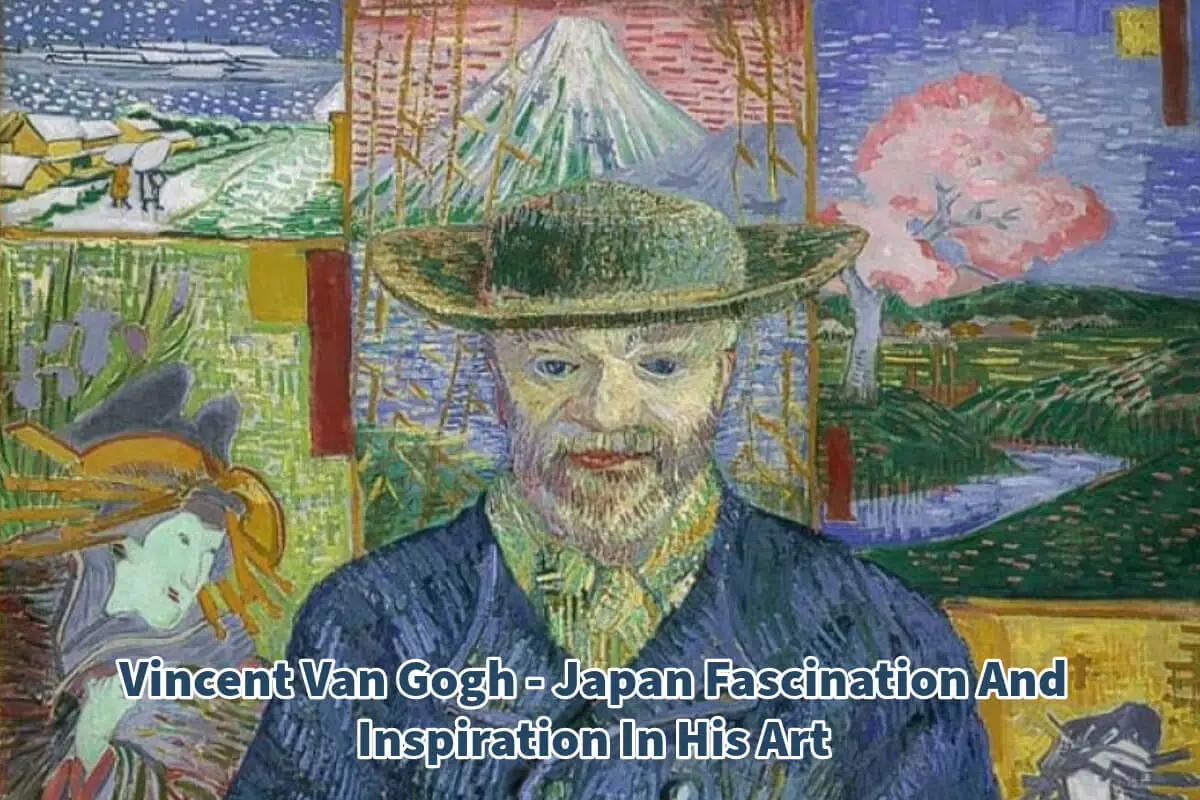Vincent van Gogh holds a special place in my heart as one of my favorite artists, undoubtedly one of the greatest ever to grace the art world.
What often goes unnoticed is Japan and Japanese art’s profound influence on his creative spirit. It’s remarkable that despite never setting foot in Japan, he admired all things Japanese, particularly their captivating art. Let’s delve deeper into the fascinating connection between Vincent van Gogh and his enduring fascination with Japan.
Table of Contents
- Vincent Van Gogh’s Enduring Fascination With Japan: A World Of Inspiration
- 15 Ways Japan And Japanese Art Inspired Vincent Van Gogh
- Bold Use Of Color:
- Simplified Forms:
- Everyday Scenes:
- Flat Perspective:
- Unconventional Cropping:
- Emphasis On Nature:
- Use Of Pattern:
- Japonisme:
- Emotion Through Nature:
- Influence On Portraits:
- Calligraphic Brushwork:
- Exploration Of Light And Shadow:
- Love For Ukiyo-e Prints:
- Influence On Composition:
- Contemplative Spirit:
- Frequently Asked Questions
- Related Questions
Vincent Van Gogh’s Enduring Fascination With Japan: A World Of Inspiration
Vincent van Gogh, one of the most celebrated artists in the history of Western art, is known for his distinctive style and innovative approach to painting. Many people may not realize that he never set foot in Japan, yet the Land of the Rising Sun had an indelible impact on his work.
Vincent Van Gogh’s His Love Of Japan
Although Vincent van Gogh never physically journeyed to Japan, it is abundantly clear that he had a profound affection for the Land of the Rising Sun and a deep appreciation for its art and culture. When considering his passion for Japan, one cannot help but wonder whether, given the opportunity, he would have readily embraced the prospect of residing in Japan, immersing himself in its vibrant milieu and gaining a richer understanding of Japan and its people.
This sentiment is eloquently expressed in a letter he penned to his beloved brother, Theo, wherein he shared his thoughts on Japan.
Vincent Van Gogh Letter To Theo Van Gogh – 16 March 1888
“But, my dear brother — you know, I feel I’m in Japan. I say no more than that, and again, I’ve seen nothing yet in its usual splendour.”
The sentiments expressed by van Gogh in his letters to his brother, Theo, vividly illustrate the profound adoration he held for Japan. His thoughts revolved around Japan, its art, and its profound influence on his artistic endeavors. Remarkably, he saw Japan as an inspiration for his art and a guiding light for his life.
15 Ways Japan And Japanese Art Inspired Vincent Van Gogh
Van Gogh’s fascination with Japan and its art is a testament to the global nature of artistic inspiration. In this blog post, we will delve into how Vincent van Gogh was profoundly influenced by Japanese art, particularly Japanese woodblock prints, despite never visiting Japan.
Bold Use Of Color:
Van Gogh was captivated by the vibrant and bold colors used in Japanese prints. He adopted this approach in his work, enhancing his use of color to convey emotion and atmosphere.
Simplified Forms:
Japanese woodblock prints often featured simplified and stylized forms. Van Gogh incorporated this aesthetic into his paintings, simplifying complex scenes to create a more impactful composition.
Everyday Scenes:
Japanese prints frequently depicted everyday life and scenes of nature. Van Gogh began to focus on these aspects in his art, moving away from traditional European subject matter.
Flat Perspective:
Japanese prints favored a flat, two-dimensional perspective. Van Gogh adopted this style, as seen in paintings like “The Bedroom,” where objects are rendered with little depth.
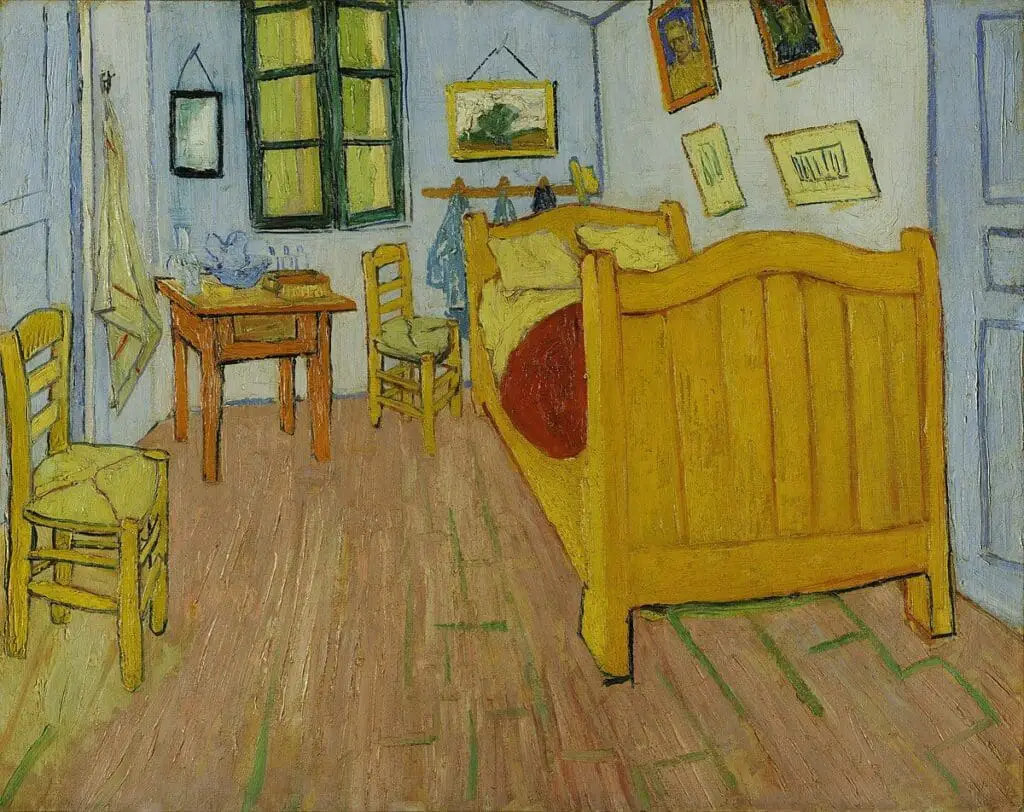
Unconventional Cropping:
Van Gogh embraced unconventional cropping and framing, influenced by the Japanese prints’ ability to capture a scene from unique angles.
Emphasis On Nature:
Japanese art celebrated nature, which deeply resonated with Van Gogh. His series of paintings featuring flowers and landscapes bear witness to this influence.
Use Of Pattern:
Japanese prints often featured intricate patterns in clothing and backgrounds, inspiring Van Gogh to incorporate patterns into his works.
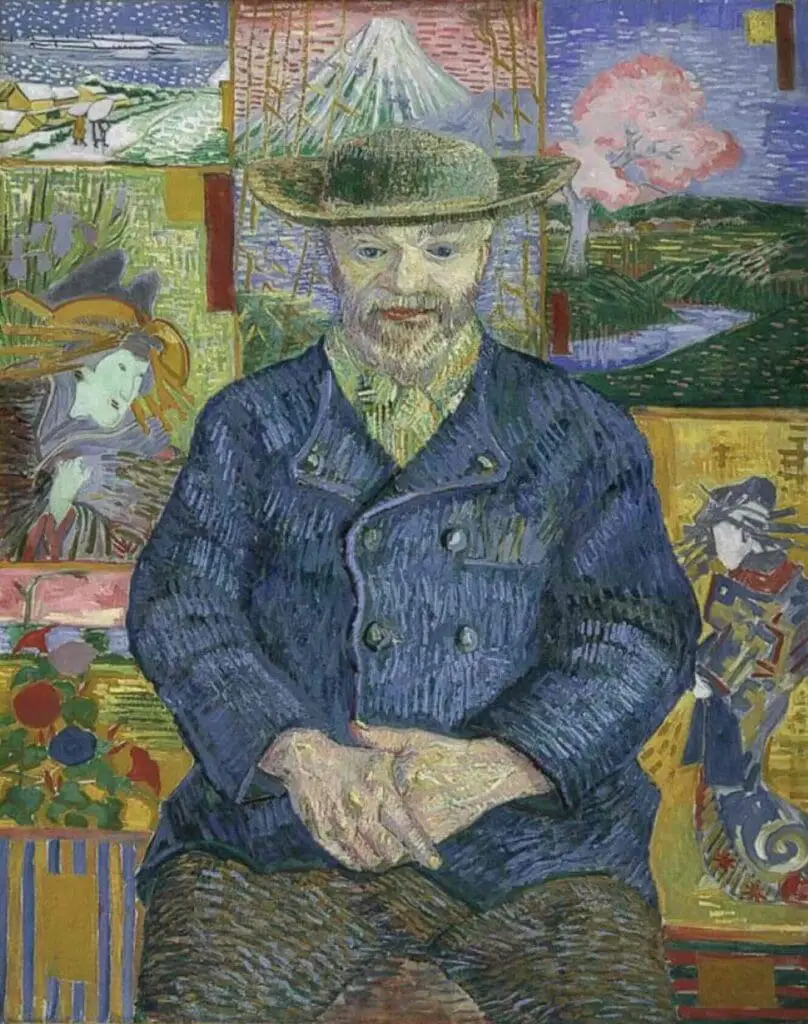
Japonisme:
The Japonisme movement, popular in Europe during Van Gogh’s time, played a significant role in introducing Japanese art to Western audiences, further influencing Van Gogh’s work.
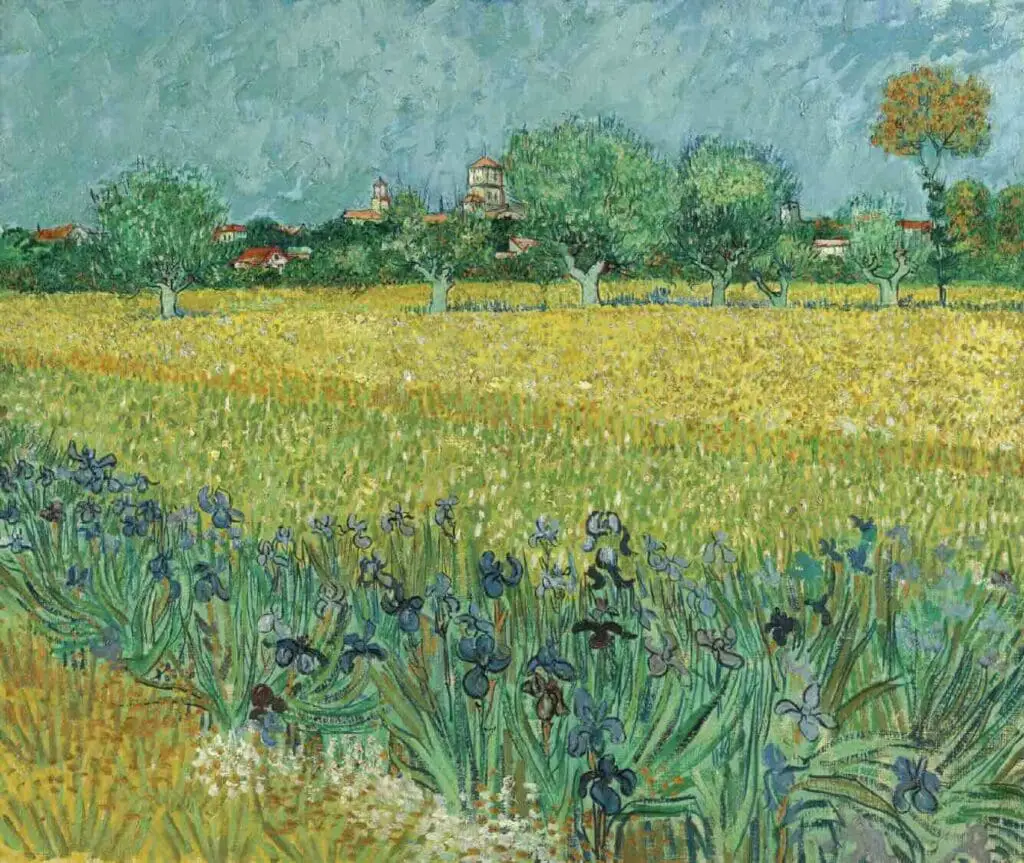
Emotion Through Nature:
Van Gogh’s emotional connection to nature, similar to Japanese art’s celebration of the natural world, is evident in his iconic “Starry Night.”
Influence On Portraits:
The Japanese influence can also be seen in Van Gogh’s portraits, where he adopted a more simplistic approach, emphasizing the subject’s character and expression.
Calligraphic Brushwork:
Japanese calligraphy and brushwork techniques influenced Van Gogh’s painting style, particularly his bold, expressive brushstrokes.
Exploration Of Light And Shadow:
Van Gogh’s exploration of light and shadow, as seen in “The Night Café,” is reminiscent of Japanese art’s use of contrasting tones to create depth.
Love For Ukiyo-e Prints:
Van Gogh was a collector of Japanese ukiyo-e woodblock prints, with many adorning his studio walls, offering constant inspiration.
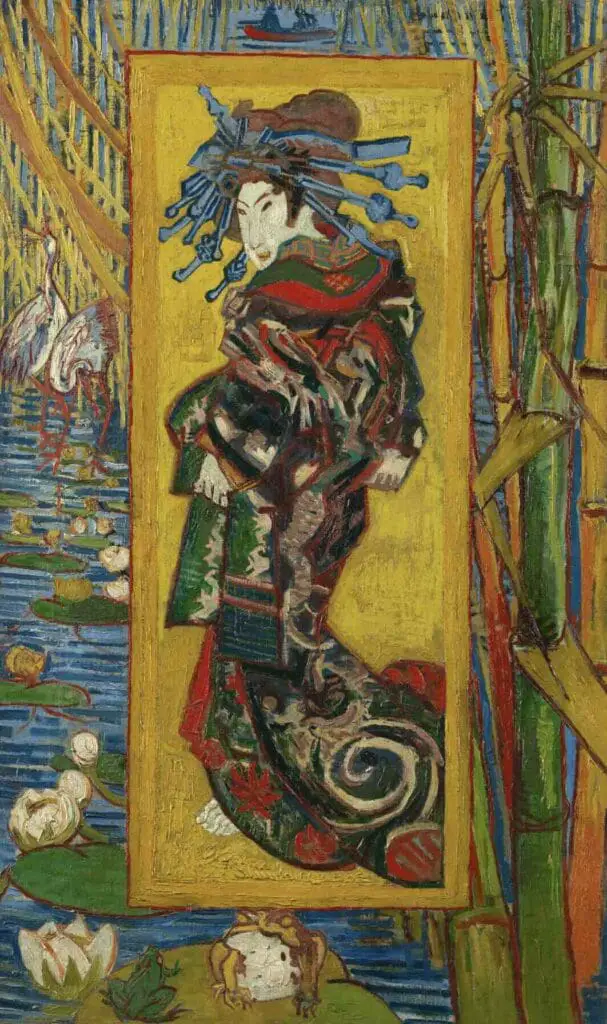
Influence On Composition:
The composition of Van Gogh’s paintings, such as “The Café Terrace at Night,” reflects the balance and harmony in Japanese prints.

Contemplative Spirit:
Like Japanese art’s serene and contemplative nature, Van Gogh’s later works exude a sense of introspection and tranquility.
Vincent van Gogh’s deep connection to Japan and its art is a testament to the power of cross-cultural influence in art. Despite never setting foot in Japan, he saw Japan everywhere and channeled the essence of Japanese woodblock prints into his iconic masterpieces.
Van Gogh’s willingness to explore and adapt new ideas and aesthetics showcases the universality of art and its ability to transcend borders and time, forever leaving an indelible mark on the canvas of creativity.
Anita Louise Art is dedicated to art education, great artists, and inspiring others to find and create their art. We love art that uplifts and inspires. #ArtToMakeYouSmile! #ArtToMakeYouHappy!
If you are interested to see any of my art, you can find out more by clicking here. If you are interested in what inspires me and my paintings, you can discover more by clicking here.
We have a free newsletter and would love you to be part of our community; you can subscribe to the newsletter by clicking here. If you have any questions, I would be happy to talk to you. You can reach me, Anita, by clicking here.
Subscribe to our Anita Louise Art YouTube Channel with great videos and information by clicking here.
Join us for our podcast “5 Minutes With Art.” Spend just 5 minutes a week with us to discover and learn about great art and artists. You can find out more about our podcast by clicking here.
Frequently Asked Questions
How did Japan influence Vincent van Gogh’s art without him ever visiting the country?
Van Gogh never visited Japan, yet Japanese art left an indelible mark on his work. This FAQ explores the ways in which Japan and its art inspired the renowned artist.
What aspects of Japanese art captivated Vincent van Gogh the most?
Discover the specific elements of Japanese art that held a special allure for Van Gogh, from traditional prints to the unique perspectives on nature and daily life.
How did Van Gogh incorporate Japanese themes into his paintings?
Explore the paintings where Van Gogh infused Japanese influences, examining how he blended Eastern aesthetics with his distinctive style to create iconic works of art.
Were there specific artists or artworks from Japan that influenced Van Gogh’s creative process?
Delve into the Japanese artists and masterpieces that left a lasting impact on Van Gogh’s artistic imagination, shaping his perception of color, form, and composition.
What role did Japanese ukiyo-e prints play in Van Gogh’s artistic development?
Learn about Van Gogh’s fascination with ukiyo-e prints and how these woodblock prints contributed to the evolution of his artistic techniques and color palette.
Did Van Gogh’s appreciation for Japanese culture extend beyond art?
Explore whether Van Gogh’s admiration for Japan extended beyond the realm of art, influencing his lifestyle, personal habits, or interactions with others.
How did Van Gogh’s contemporaries and the art world react to his incorporation of Japanese influences?
Investigate the reception of Van Gogh’s work, infused with Japanese aesthetics, among his contemporaries and within the broader art community during his time.
Were there any challenges or controversies related to Van Gogh’s fusion of Western and Japanese artistic styles?
Examine if Van Gogh faced any challenges or controversies for blending Western and Japanese artistic styles, and how he navigated these issues within the art world.
Did Van Gogh’s Japan-inspired works receive recognition during his lifetime, or was it a posthumous acknowledgment?
Uncover the timeline of recognition for Van Gogh’s Japan-inspired works, exploring whether they gained acclaim during his lifetime or if their significance was realized only after his death.
How does Van Gogh’s Japan fascination contribute to his legacy in the art world today?
Reflect on the enduring impact of Van Gogh’s admiration for Japan, considering how it continues to shape perceptions of his legacy and influence contemporary artists and art enthusiasts.
Related Questions
How Did Vincent van Gogh’s Paintings Become Famous?
Vincent van Gogh’s painting became famous because his sister-in-law took her upon herself after his death and the death of her husband, Theo, to find a way to get his paintings and names out to the world. She was brilliant and savvy in how she did this. By the time she died in 1925, Vicent van Gogh was world-renowned.
By clicking here, you can learn more by reading What Was The Impact Of VinHow Did Vincent van Gogh’s Paintings Become Famous?
Why Is Van Gogh Considered Such a Great Artist?
Many things make Vincent Van Gogh unique and great as an artist. He had a great way of using color in his heart, but more than that, he was an artist who set and paved the way, and his brushstroke technique used color and his design ability. What is interesting is that he did this as a self-taught artist.
By clicking here, you can discover more by reading Why Is Van Gogh Considered Such a Great Artist?
How Much Is Van Gogh’s Starry Night Worth?
Van Gogh used color, form, and emotions in his art. He had a bright palette that was individualized for his time. Even though he did not see a lot of success during his life after he died, the impact of his art can be seen in both the Expressionism and Fauvism movements that were taking place in Europe.
By clicking here, you can learn more by reading How Much Is Van Gogh’s Starry Night Worth?, And Other Facts.

